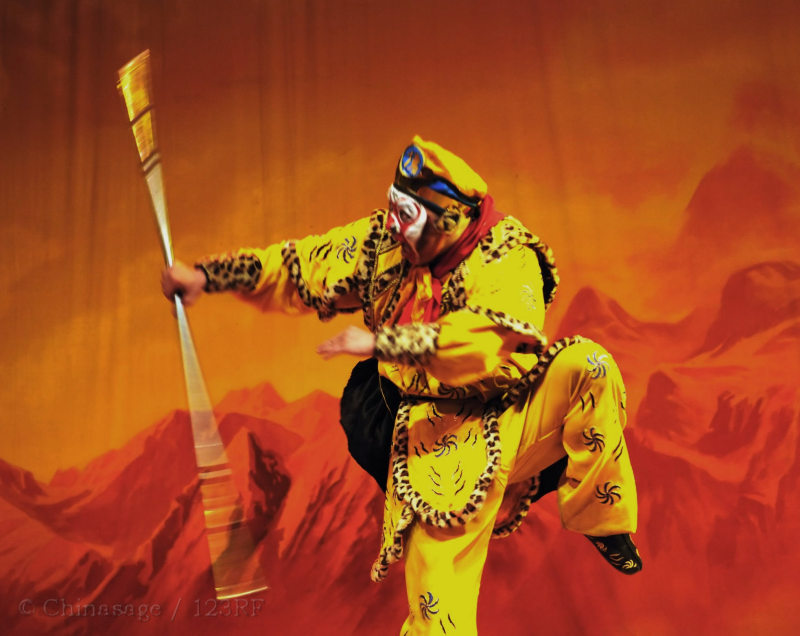Chinese Opera : 戏曲 Xì qǔ
In his ‘Civilization of China’ (1911) Herbert Giles wrote “For pleasure pure and simple, independent of gains and losses, the theater occupies the warmest place in every Chinaman's heart.”. It was for centuries the top form of entertainment in China. It also goes by the name 国粹 Guó cuì meaning Quintessence of the nation.
Chinese Opera is an art-form that has many elements: music, dance, acting, mime, comedy, tragedy, acrobatics and martial arts. An aspiring opera performer has to learn how to 唱念做打 chàng niàn zuò dǎ sing, talk, act and fight. Over the centuries the artform has continued to be refined. As in much of Chinese art, the aim is to recreate former masterpieces. There are strict rules and conventions that limit creativity and yet each generation seeks to surpass what has gone before.
Operas are classified as either Wenxi (civilian plays) or Wuxi (military dramas) and also as dramas, comedies or farces. The story-lines come from folk tales, legends and classical literature - anything too contemporary was considered politically dangerous. It was forbidden to portray Emperors or Empresses of the current dynasty.
The art was admired by European visitors, J.D. Vaughan wrote in the Penang Gazette in 1853 “...The scenes that followed I think you will allow deserve to be classed among our best farces. The characters are well sustained and the part of the young huntsman Ma Guan, well played...”.
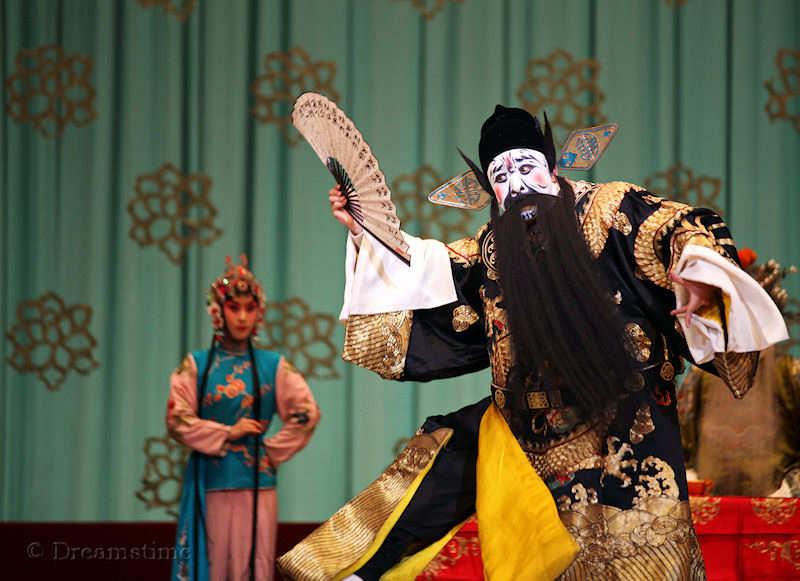
Chinese Opera History
There is evidence for opera as far back as a thousand years when Emperor Xuanzong created a troupe to perform in his ‘Pear Garden’, to this day opera performers are colloquially known as ‘Children of the Pear Garden’ 梨苑子弟 lí yuàn zǐ dì. The province of Shanxi was the initial center for this new art-form. The opera was further developed in the Song dynasty and taken up during the Mongol dynasty with hundreds of local forms competing for audiences. At this time the opera became more regimented with the Imperial form consisting of four acts each with a different principal actor.
In the Ming dynasty, Kunqu Opera 昆曲 kūn qǔ (or just Kun), originating from Suzhou, Jiangsu, became the most important form. Characteristically the bamboo flute is used as a melodious accompaniment in these operas. Some of the best loved works were written for Kunqu Opera from this time including “The Peony Pavilion”, “The Peach Blossom Fan”, “Romance of the Three Kingdoms” and “Journey to the West” (which tells of the Monkey King's impish antics).
At the same time more roles were created including 丑 Chǒu and 净 Jìng. Jing is a striking, aggressive role while Chou is a sort of clown (the Chinese character means ‘ugly’) that introduces earthy humor into the opera.
Opera was somewhat similar to the state of European theater in the pre-Elizabethan era, as, for example the boys played the female parts and the sets were very bare. However unlike Europe, the Chinese form changed little in the following centuries. The repertoire was not enlivened by new stories and the lowly status of actors continued. For example, actors and their children were not permitted to enter the Imperial examinations and remained a class apart.
There are a variety of forms in different regions of China through the ages but they broadly follow similar lines.
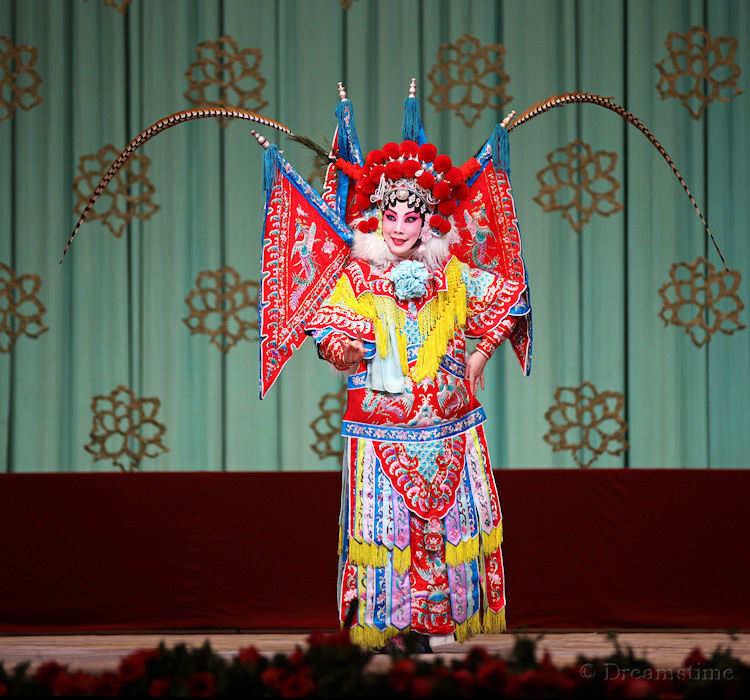
Peking Opera 京剧 jīngjù
Qing Emperor Qianlong is credited with developing Beijing (Peking) Opera from the Kunqu and other forms which he saw in Anhui and Hubei provinces. It merges singing, acrobatics, mime, dance and dialogue into a single artform. Dowager Empress Cixi was a great fan and patron of all the great actors of the day. As many as 10,000 operas were written at the peak of its popularity. This remains the best known form of Chinese opera.
Regional variants in Sichuan, Shanxi, Hao, Puxian, Shanghai and Guangzhou have all survived. Shanxi opera is known for acrobatic and fire-breathing interludes. Shanghai Huju opera is relatively modern and uses simpler costumes and make-up, it was most popular in the cosmopolitan era of the 1920s and 1930s. The Cantonese form uses more acrobats and martial artists and has a huge repertoire - 11,000 operas have been written over the last 700 years.相声 Xiàng sheng is a comedic theatrical form often as a solo performer in a tea house or small theater. Hoewever these local forms usually sung in the local dialect now struggle to find a national audience.
There are some similarities between Chinese Opera and Japanese Noh Theater ➚ and it is thought the development of Noh theater in the 14th century was strongly influenced by Kunqu Opera. The principal difference is that Noh theater uses a range of masks.
Changes came with the fall of the Qing dynasty and the creation of the People's Republic. The trauma of the modernization of opera in the early 20th century is brought to life by the well known film Farewell my Concubine ➚. One of the most famous opera actors of this time (1930s) was Mei Lanfang ➚ who played ‘dan’ roles.
In 1960 the new Communist government commissioned a new opera by Wu Han ➚ to demonstrate the historic right of people to oppose the feudal system. However the opera was taken as an invitation for people to criticize Mao's new government. The opera was quickly withdrawn. The major break from the past came with the Cultural Revolution. Mao's fourth wife Jiang Qing was an actress and began zealously reforming the arts. Traditional Beijing Opera was banned during the Cultural Revolution because the stories were about the old, feudal structures of society.
Jiang Qing introduced a small repertoire of Revolutionary Operas that broadly followed the classical form but were now based on stories where the bad guys were land owners, aristocrats and merchants; however the music and movements came from the classical tradition, only the costumes and narrative were modern. A series were written about the revolts of peasants in the 1920s: ‘The Red Guard on Lake Honghu’; ‘the White-haired Girl’; ‘the Crossing of the River Dadu’; anti-Japanese operas: ‘Revolution Goes On’; ‘the Spark among the Reeds’; operas about the Korean War: ‘Raid against the White Tiger Regiment’ and ‘To Try the Chair’. On the fall of the Gang of Four in 1976 the revolutionary operas soon disappeared.
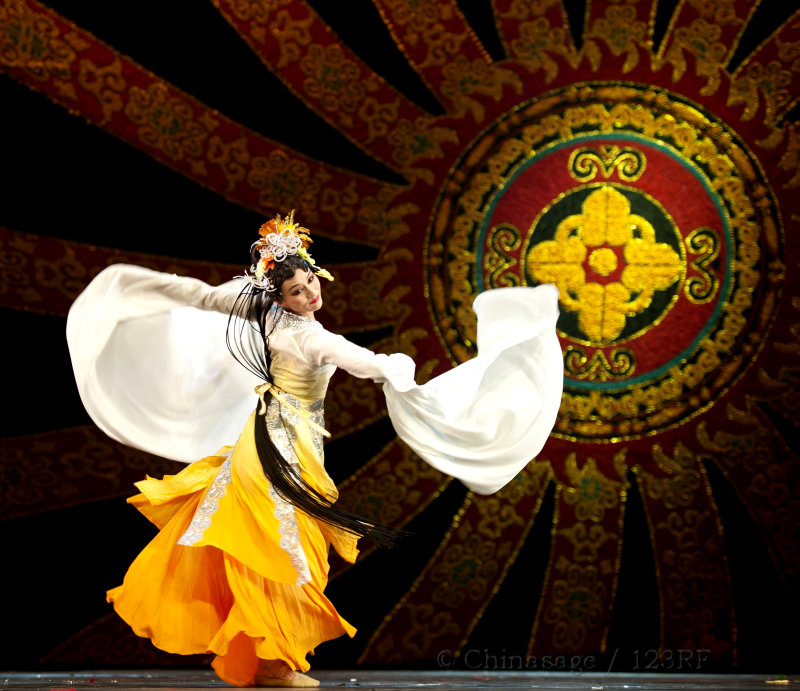
Since the 1980s the classic form has been revived but has struggled to find large audiences now that a wide range of other entertainments are available. Tourists, both Chinese and foreign, rather than locals provide the bulk of the modern audiences for classic opera. Committed fans such as Wang Yumin have made considerable efforts to keep the art-form alive.
A night at the Chinese Opera
Generally an evening at the Opera consisted of a series of short plays without a break giving the impression of a very long single work. The emphasis is on narrative rather than in psychology or character study. Some opera parts are very long and each actor may improvise a little so that each performance will be different.
The stage is bare and open on three sides; very few props are used so a lot of gestures and make believe are needed to create a scene. The lack of props made it easy for opera troupes to hold their performances outdoors, and to take them to local temples and market fairs. The bare set requires the actors to use all sorts of shorthands for different actions (such as riding a horse is indicated by holding a whip; a city wall or a prison by a chair). The sparseness of this artistic form inspired many Western playwrights and composers to write pieces based on minimal theatrical resources. The complexity is best demonstrated by the fact there are 50 ways of moving a sleeve each with its own dramatic meaning. The use of the long white ‘water sleeves ➚’ is characteristic of Chinese Kun Opera. The bareness of the stage was counterbalanced by the richness of the costumes and make-up.
Small props are used to indicate character types. For example a young scholar is identified by carrying a fan. Actors dressed in black are considered 'invisible'; while carrying a horse hair switch indicates a supernatural creature. A general will have a bag full of banners on his back, the number of banners representing the size of his army.
The audience do not remain quiet, there is fairly continuous chatter. Snacks and tea are served and people move around during the performance. The most famous actors were kept back until the last part of the very long performance (traditionally it could be five hours or more) when the rich patrons had arrived.
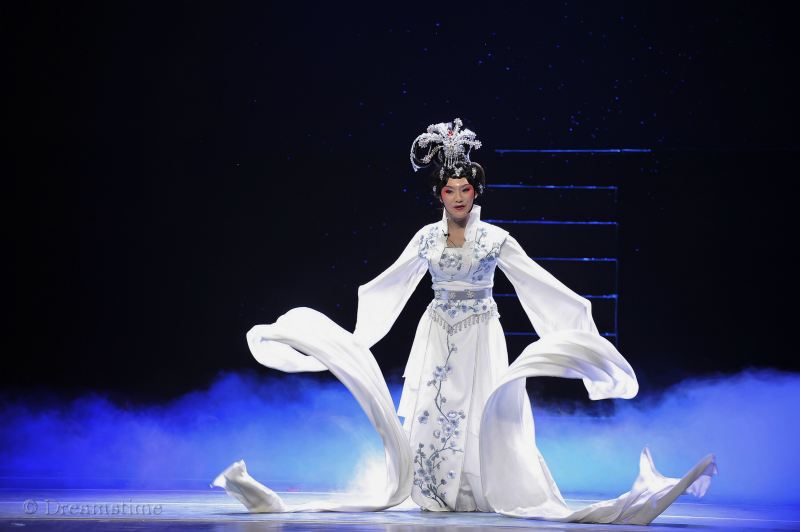
Performance
Apprentice actors for the Opera required dedication, they were recruited very young (aged 7 or 8) and underwent rigorous gymnastic and martial art training as well as singing and acting. Lessons start at 6:00am and include singing, acrobatics, choreography and martial arts. As with martial arts students study in a school under a master (师公 shī gōng). Students aim to accurately copy the moves of their master. Emotional as well as physical training is required. Mastering a single theatrical gesture requires a great deal of training. There is a yin-yang balance in performance between gentle graceful moves and energetic acrobatics. In a few years it is apparent which type of role the trainee actor is suited to: male or female (in the days when men played all the parts), villain, comic, hero and then they will play only characters of that role type for the rest of their acting career. The repertoire is fairly limited and well known to most of the audience who therefore pay more attention to individual performer's interpretation rather than the story. The dialogue can be difficult to follow, so now surtitles are often displayed to help the newcomers in the audience.
Originally there were just four character roles, 老生 lǎo shēng (elderly man) who played emperors, generals and servants; 武生 wǔ shēng for military heroes. A wusheng needs to be a good acrobat as well as a good singer. 青衣 qīng yī is the leading female part often a high-born maiden or a simple country girl. 花旦 huā dàn (dan) is often a courtesan or slave girl. 小生 Xiǎo shēng is the juvenile male role but never the main lead.
The female opera roles used to be played by young men as it was considered indecent for men and women to work together as actors. Qing Emperor Qianlong explicitly forbade female actors for his new Beijing operas. The ‘women’ talk with a high pitched sing-song voice and sing in falsetto. This came to an end with the creation of the PRC and now women play the female roles.
The make-up is put on thickly over much of the face in standard designs and color schemes with well understood conventions. White make-up is used to clearly identify the villain; black for kind but forceful characters. Generals and warriors have bright red and yellow make-up as red indicates loyalty and courage; purple solemnity and fairness; green for wild and impulsive; blue for fierce and far-seeing characters. Generally the good characters have simple, smooth patterns of make-up while the evil ones have complex designs. The costume and make-up are all that is needed to identify a character.
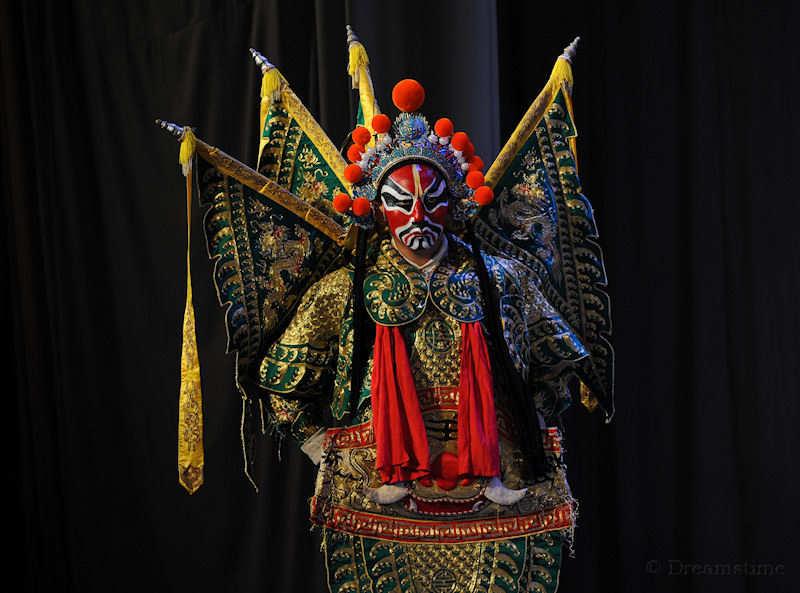
Chinese Musical Accompaniment
Musical accompaniment is provided by a band of musicians often in plain view to the right hand side of the stage. Traditional instruments are used with heavy use of percussion. Chinese people use the phrase to go to ‘listen to the Opera’ rather than ‘watch the Opera’. Connoisseurs may sit with their eyes closed to fully appreciate the music and singing as it is such an essential part of the performance. Typically there will be about ten musicians playing a range of instruments: the erhu and huqin (stringed instruments); sheng (mouth organ); pipa (lute); suona (trumpet); gongs; wooden blocks and drums.
